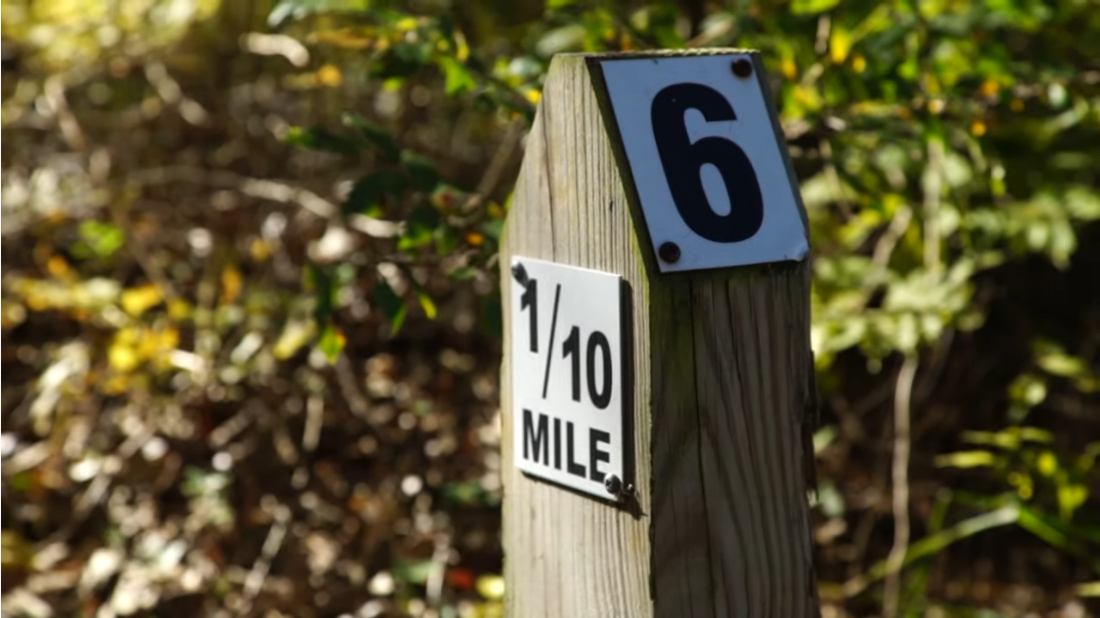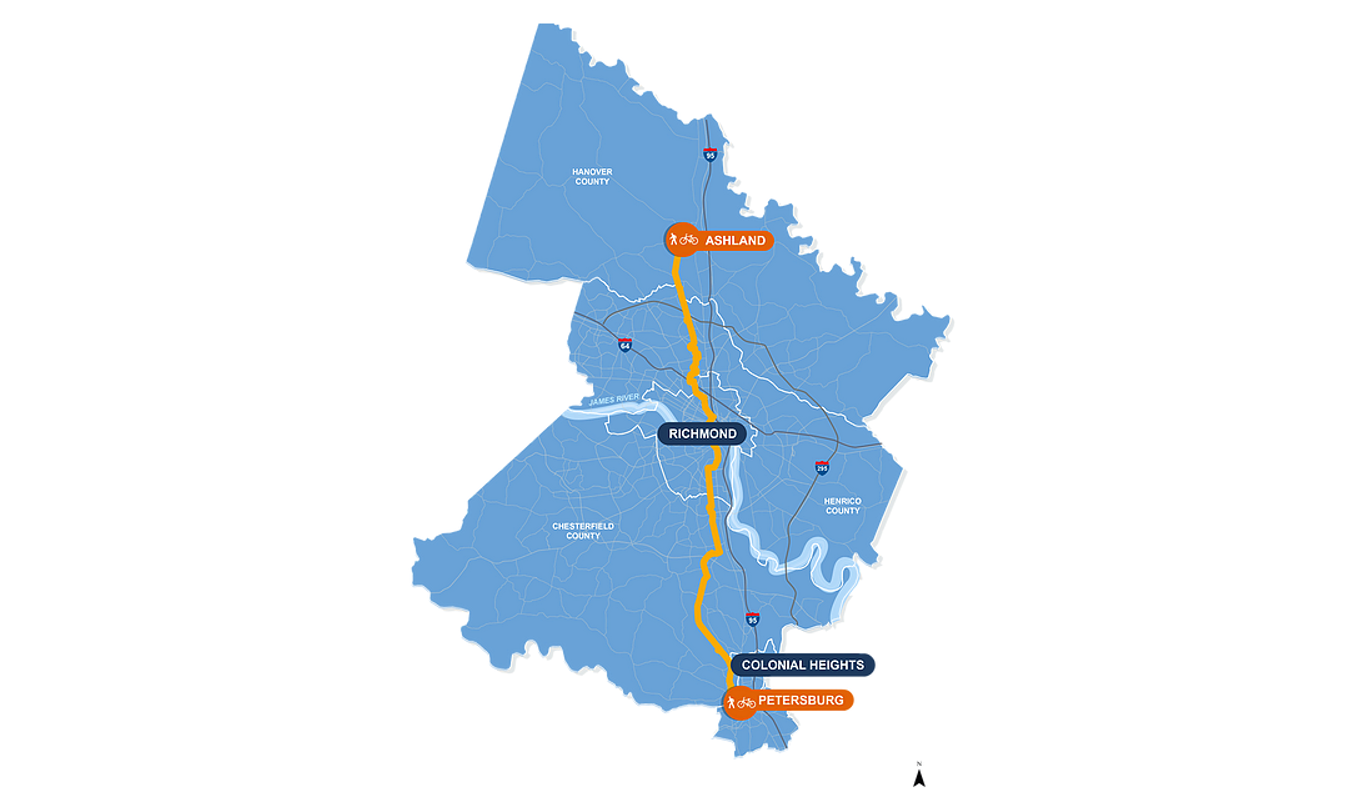
Brantley Tyndall of Sports Backers walks a section of the proposed Fall Line trail at Great Branch Creek in Chester in 2020. (BizSense file images)
The money needed to cover the costs of a proposed 43-mile regional walking and biking trail continues to fall into place.
The Central Virginia Transit Authority voted Friday to allocate $104.5 million toward the Fall Line, which would run from Petersburg to Ashland.
The authority also voted last week to make a formal request of the governor’s office to include in the state budget the remaining $132 million needed. About $73 million in state and local funding is already considered committed toward the project.
The CVTA is a regional authority established last year to allocate tax revenues to transportation projects in the region. Richmond, Henrico, Chesterfield, Hanover, Ashland, Goochland, Powhatan, New Kent and Charles City are represented on the authority.
The Fall Line’s current cost estimate now sits at about $300 million. The authority’s expectation is that cost projections will continue to be tweaked in the coming years as the trail is built out.
The latest estimate factors in 3 percent annual inflation through fiscal year 2027 based on a recent VDOT project estimate of $250 million in 2021 dollars, CVTA Interim Executive Director Chet Parsons said at the meeting.
“We’ve had time to think more and the technical committee understood these estimates were based on 2021 dollars and that may not be the most realistic way to present our case to the state for funding assistance,” he said.
Leading the project is Richmond nonprofit Sports Backers. Local governments and The Capital Trail Foundation are also involved in the project.
Louise Lockett Gordon, director of Sports Backers’ Bike Walk RVA program, has said she hopes the Fall Line will be completed within a decade. The project kicked off under the name Ashland to Petersburg Trail with a feasibility study in 2019.

A mile marker at Chester Linear Park. The proposed Fall Line trail would largely feature new construction but would also link existing trails on the route.
The trail would largely be new construction, though it would link existing trails at Chester Linear Park and Ashland Trolley Line Trail as well as other planned local projects.
There isn’t a set start date for trail construction yet, Parsons said in a phone call after the meeting. The CVTA is expected to meet in January and at that point Parsons said there would be a firmer idea of where things stand on existing local efforts and what to work on next.
The trail is similar to the 52-mile Capital Trail, which links Richmond to the Williamsburg area and was fully operational in 2015, in that it’s a paved walking-and-biking trail that runs through several localities.
But whereas the Capital Trail mostly runs through rural areas and is largely used as a recreational amenity, Gordon has said the assumption is that most Fall Line users will be travelers as the north-south line will more regularly pass through suburban and urban areas.
CVTA’s Fall Line contribution comes in slightly south of a previous funding projection of $108 million.

Brantley Tyndall of Sports Backers walks a section of the proposed Fall Line trail at Great Branch Creek in Chester in 2020. (BizSense file images)
The money needed to cover the costs of a proposed 43-mile regional walking and biking trail continues to fall into place.
The Central Virginia Transit Authority voted Friday to allocate $104.5 million toward the Fall Line, which would run from Petersburg to Ashland.
The authority also voted last week to make a formal request of the governor’s office to include in the state budget the remaining $132 million needed. About $73 million in state and local funding is already considered committed toward the project.
The CVTA is a regional authority established last year to allocate tax revenues to transportation projects in the region. Richmond, Henrico, Chesterfield, Hanover, Ashland, Goochland, Powhatan, New Kent and Charles City are represented on the authority.
The Fall Line’s current cost estimate now sits at about $300 million. The authority’s expectation is that cost projections will continue to be tweaked in the coming years as the trail is built out.
The latest estimate factors in 3 percent annual inflation through fiscal year 2027 based on a recent VDOT project estimate of $250 million in 2021 dollars, CVTA Interim Executive Director Chet Parsons said at the meeting.
“We’ve had time to think more and the technical committee understood these estimates were based on 2021 dollars and that may not be the most realistic way to present our case to the state for funding assistance,” he said.
Leading the project is Richmond nonprofit Sports Backers. Local governments and The Capital Trail Foundation are also involved in the project.
Louise Lockett Gordon, director of Sports Backers’ Bike Walk RVA program, has said she hopes the Fall Line will be completed within a decade. The project kicked off under the name Ashland to Petersburg Trail with a feasibility study in 2019.

A mile marker at Chester Linear Park. The proposed Fall Line trail would largely feature new construction but would also link existing trails on the route.
The trail would largely be new construction, though it would link existing trails at Chester Linear Park and Ashland Trolley Line Trail as well as other planned local projects.
There isn’t a set start date for trail construction yet, Parsons said in a phone call after the meeting. The CVTA is expected to meet in January and at that point Parsons said there would be a firmer idea of where things stand on existing local efforts and what to work on next.
The trail is similar to the 52-mile Capital Trail, which links Richmond to the Williamsburg area and was fully operational in 2015, in that it’s a paved walking-and-biking trail that runs through several localities.
But whereas the Capital Trail mostly runs through rural areas and is largely used as a recreational amenity, Gordon has said the assumption is that most Fall Line users will be travelers as the north-south line will more regularly pass through suburban and urban areas.
CVTA’s Fall Line contribution comes in slightly south of a previous funding projection of $108 million.

It’ll cost $300 million to build an asphalt trail on already owned right of ways?!! I realize that some over passes will be necessary, but come on!
300M seems excessive for a public bike trail? I’m sure there are other VA public programs that could use the money. Programs that would serve a wider population who actually need the public funding for food, shelter, etc…
At the least 300 million could go to other local sidewalk and bike path projects vs one colossal one. But the reality is this project is made up of several bike and sidewalk projects that should have been built back in the 1990’s at the least.
The Capital trail does have a lot of heavy bike path traffic and this trail due to it being more urban will have a lot more bike traffic on it though.
A quick search on construction costs for a new 4-lane HWY costs roughly 4-6M per mile. Quick math from this article tells me the bike path will cost on average 7M per mile. Again 300M for a bike path (a want not a need) seems excessive…
While your estimate makes the trail seem excessively expensive, I think you are assuming highways are far cheaper per mile than they actually are. Based on 2014 figures, with minor rounding up (not nearly enough to account for inflation), I’d guess that a 4 lane highway would cost, at minimum, 2.5 million per LANE mile, OR 10 million per Hghway mile. Which comes out to 430 million for an equivalent highway, as oppposed to a 300 million for this bike lane. However, that assumes that the highway is on undeveloped rural land. Adding new lane miles in a city, in… Read more »
@Lee, here’s a cost study done in Indiana 2-3 years ago. It maxes out at less than $2,000,000/mile. Remember, these paths have FAR less aggregate and asphalt, far less need for earthwork (vertical an horizontal alignment), far less bridge costs and far less R/W or easement width. It really doesn’t compare to a road that carries motorized vehicles and heavy trucks. Here’s the link:https://www.in.gov/indot/files/INDOT_TrailsCostCalculator_Memo.pdf
Since 57% of the money needed is accounted for, work should begin ASAP. Since it doesn’t appear that any Federal Funding is involved “prevailing wages ” shouldn’t be an issue. This would enable small, and minority contractors to be involved, since non-union labor could be used.
This could lower the final cost of the project.
A win-win for all Virginians!
Prevailing wage is now a state requirement
Seem like a waste of funds.
Looking forward to having this trail one day! Very exciting and worth the cost.
Over and over, people say they want walkable/bikeable communities; the Fall Line Trail will serve as the “spine” of a growing metro area. Some critics also said the Capital Trail would be a waste of money. In truth, it has been not only a boon to mobility and recreation, but to the area’s economy (https://rvahub.com/2020/07/02/new-report-finds-virginia-capital-trail-generated-8-9-million-in-local-economic-activity-last-year/). You can find a host of other studies about the economic impacts of trails at https://www.pedbikeinfo.org/factsfigures/facts_economy.cfm, and studies about how they create healthy communities at https://www.pedbikeinfo.org/factsfigures/facts_health.cfm (and healthier populations also have economic benefits, btw). In time, I predict the Fall Line Trail will become one… Read more »
Denis, don’t confuse comments about the costs with the need for such infrastructure. Some here are familiar with the cost of development, and the suggested costs are far too high. If it can be completed for, say, $100,000,000 less, is that not a fair request?